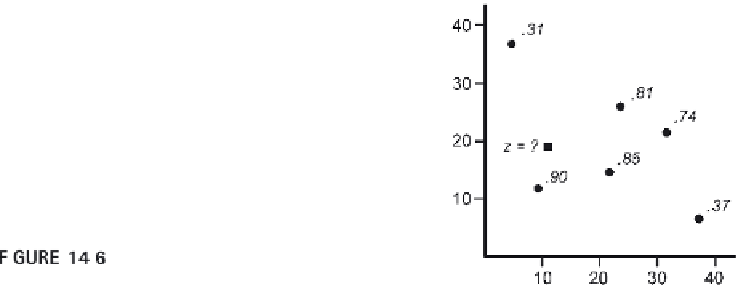Geography Reference
In-Depth Information
ments recorded at individual points, making spatial interpolation a very use-
ful transformation.
A number of factors influence spatial interpolation. Most significantly,
the choice of technique will have great impacts. A number of statistical tech-
niques, from simple to complex, are available. Choosing one depends on a
number of factors and experiences. The two techniques that are often used
are the local spatial average and the inverse-distance-weighted spatial aver-
age. Splines and multiquadric analysis and TINs are also widely used, but this
section focuses on spatial averaging as a start.
Local spatial average interpolation considers multiple sample point val-
ues when determining the interpolation. The interpolation can specify the
maximum area for calculating the average, the number of points, and the
maximum distance a point can be considered in the average. Closely and
regularly spaced sample points can be interpolated with little overlap or
blank spaces. If the sample points are irregularly spaced or far apart, the
interpolation may end up with gaps and deviate from the actual values con-
siderably. Increasing the area for averaging may help, but can also turn the
interpolation into averages that bear little resemblance to the actual area and
the sample points. Just considering the nearest-neighbor sample points is
more reliable, but can produce inaccurate interpolations if the points are far
apart.
The inverse-distance-weighted spatial average interpolation offers some
possibilities to address the weaknesses of local spatial average interpolation.
This technique gives nearby points more significance in calculating the inter-
polation than more distant points. The weight is proportional to the inverse
distance between the origin point and the sample point to be interpolated.
In other words, as distance decreases the significance of the sample point
increases. This weighting takes account of autocorrelation.
The weights (see Figure 14.6) vary by distance. The distance weighting
can be altered. In the figure, it is close to a linear relationship between the
distance and the weight. Other than the weighting itself, the resolution of
the grid being produced by the interpolation and the order of choosing
Example of weights assigned to ele-
vation (
z
) based on distance point being evaluated.


Search WWH ::

Custom Search